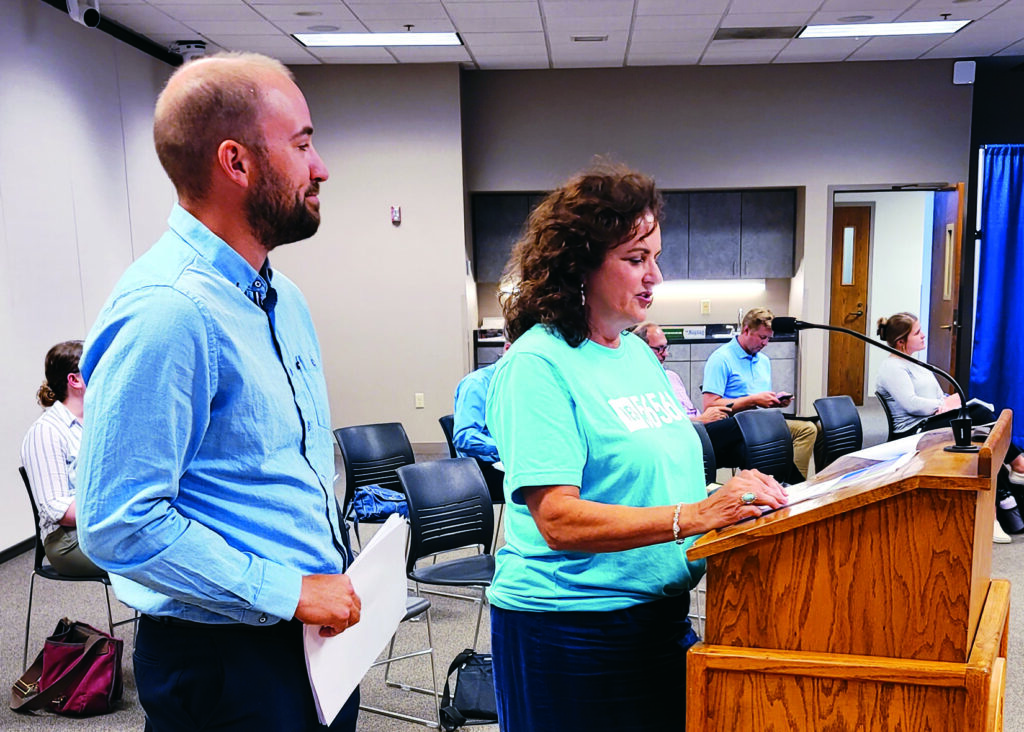
Task force co-chairs James Hand and Lisa Borgen describe plans for the community center and library to the Moorhead City Council Monday. (Photos/Nancy Hanson.)
Nancy Edmonds Hanson
What should a Moorhead-style community center and library look like? Proponents of the dream unveiled city residents’ vision this week in a pair of presentations illustrating the possibilities.
Almost a year of listening to their neighbors’ ideas went into the concepts that the Mayor’s Task Force unveiled Monday and Tuesday before the Moorhead City Council and Clay County Commission. “They’re concepts, not plans,” Mayor Shelly Carlson stressed. “Plans cost money. Until we all vote ‘yes’ in November, we’re not spending any.” The attractive renderings she and co-chairs Lisa Borgen and James Hand displayed were created by JLG Architects as a pro bono project, rooted in the most common responses from more than 1,000 members of the public who have taken part in citywide listening sessions, online surveys and written suggestions submitted at the library.
Among the components of what’s being termed the “community living room”: New library facilities, of course, with ample space for children’s programming, computer and internet access, meeting rooms, study areas and storage for its collection of 60,000 books and other publications. The basement of the present library, dating back to 1962, now hosts three to four dozen community groups a month, from Scouts and a writers group to League of Women Voters and lawyers pursuing continuing education credits. The building will also house the Lake Agassiz Regional Library, which serves rural communities from Bagley and Ada to Barnesville and Breckenridge, Detroit Lakes and spots in between.
Severe structural issues prompted the city five years ago to list the present building on its red list of compromised facilities. Among the shortcomings are its HVAC system, plumbing, electrical system and a perennially leaky roof, too numerous and costly to repair.
And both the look and the role of libraries has changed in the past 60 years. “Libraries today are much more than shelf after shelf of printed and bound books,” Borgen explains. “The library is a place where people can connect with information and with others. Certainly there are books, but they’re a smaller part of the big picture. They’re a place to hold meetings, to bring your kids, to get together with your book club … to do research, apply for jobs over the internet, work with a tutor, conduct an interview …
“And while you’re there and your kids are playing nearby, wouldn’t it be nice to grab a cup of coffee?”
But the vision is far broader. As described by Borgen and Hand, the community center portion would incorporate an indoor playground where youngsters could work off excess energy, a pleasant and airy walking track (“easier to walk on than those cobblestones in the mall,” one said), comfortable public areas where individuals of every age could relax and get to know their neighbors, and even a coffee bar to offer “adult beverages” to library patrons, walkers and parents whose offspring are running, jumping and generally having a good time.
Along with spaces for meeting and learning, the library center will incorporate more of what the mayor calls “layers of opportunities.” One is an area for makers – a place where entrepreneurs can pursue their dreams. A million-dollar grant for such purposes, she said, is now included in the federal budget proposal; She envisions it being used for such amenities as a 3-D printer and podcast room. “This is just the beginning,” she added. “Who knows how big this could become?”
Envisioned as a 55,000-sq-ft facility with multiple walking levels and lots of windows, the library and community center has been pegged at $31.5 million – an amount the proposed half-cent sales tax will raise over 22 years. According to research by the University of Minnesota Extension Service, the additional cost to residents would be an average of just $2 per month, with visitors paying almost one-third of the total amount raised. The tax would expire after the capital cost was paid.
Passage of the tax measure would raise the local tax from 7.375% (which now includes half a cent for the Law Enforcement Center) to 7.875%. Fargo and West Fargo each now levy 7.5%, but West Fargo is also weighing a local half-cent boost. That would place Moorhead’s level, including the tax under consideration, squarely in the middle. The tax would apply only to goods and services now taxes in Minnesota, not including many exempt items including food and clothing.
Between now and the election, the task force and other community volunteers will be sharing the vision with as many community groups as they can reach through presentations and “tabling” at events around town. To book a presentation, contact the mayor.
Carlson, Borgen and Hand emphasize that the center and library proposal offers economic benefits far beyond the opportunities for learning, recreation and socializing it provides to area residents. “This is Moorhead’s time to be bold,” she asserts. “This will be a catalyst for all the rest of the downtown redevelopment. Developers are attracted to locations that are already teeming with people, and this fills the bill.
“The Moorhead community center and library will be the kindling that lights the fire.”
For more information on plans and updates, including opportunities to arrange speakers and assist with the campaign, go to www.YES56560.com.


